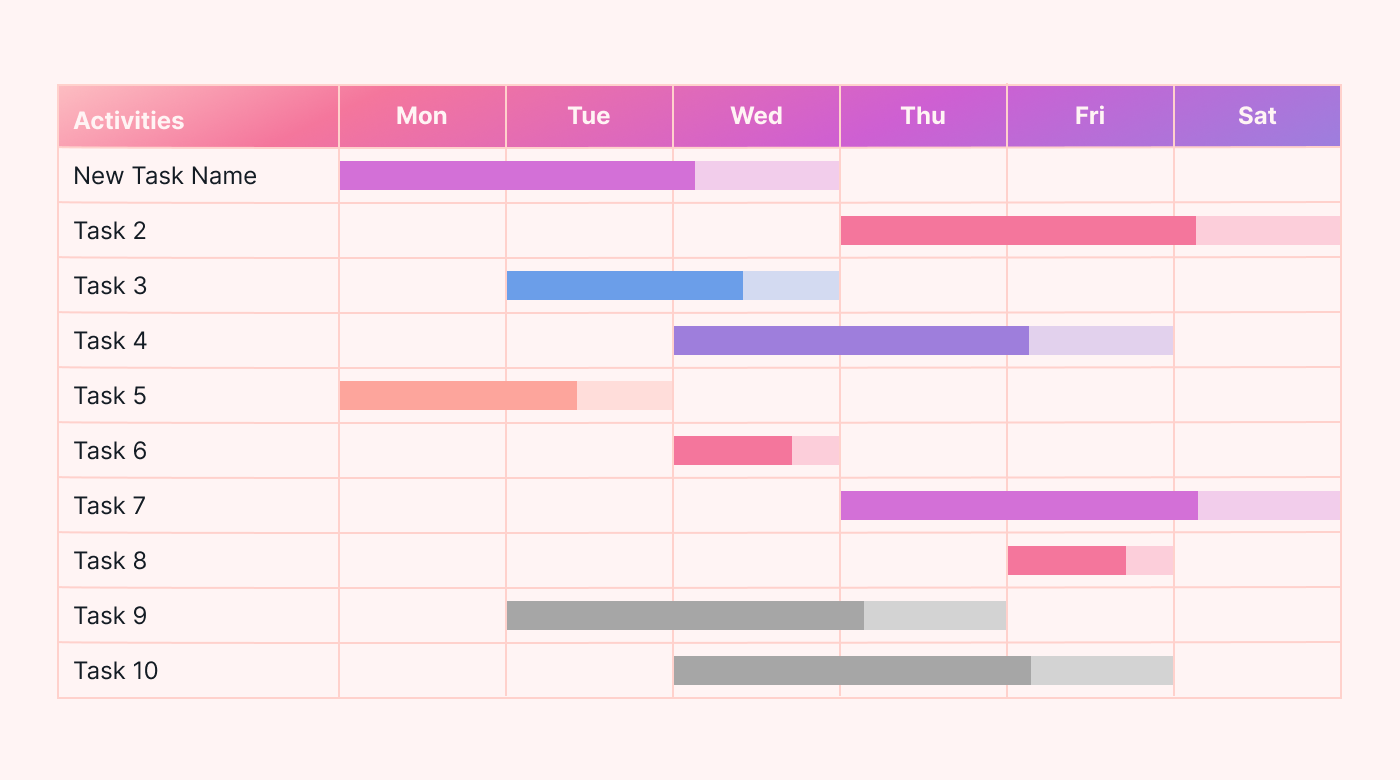When managing a project, do you ever wonder what would happen if the project sponsors informed you they would be present during the next project phase only to realize you had not procured the requisite materials or skills? What would you do?
According to a report published in 2021, only 58% of project managers follow a defined schedule. Additionally, less than 48% of project managers baseline their project schedules. This means many project managers cannot track their project’s progress.
Save yourself this trouble by having a comprehensive project schedule.
A good project schedule should define your project’s scope, including what should be done, when and how it will be done, and what resources you will need.
In this article, we’ll cover:
- project scheduling, including its benefits,
- how it compares to project planning,
- components of a project schedule,
- project scheduling steps,
- and important scheduling tools.
What is project scheduling?
Project scheduling identifies the tasks and resources needed to achieve a desired outcome. The project tasks are then plotted out over time. The individual tasks should be organized logically based on urgency and value.
A good way to know which tasks to include in a project schedule is that they should be measurable. Including tasks that are not may make the work ambiguous and confusing for team members.
 |
The Berlin Brandenburg Airport is a real-world example of a company that missed the mark on project scheduling. Its history dates back to the 1990s. The City of Berlin wanted to build an airport to reduce congestion in other state airports. Project planning began in 1993. By 1996, the state had already identified and set aside the site where they would build the airport. However, the project soon faced multiple challenges, especially poor planning.
Construction didn’t start until 2006. Still, the project lacked a clear schedule. This dragged out the project until it was completed in October 2020. The airport still faces operational issues years after its completion. It has lost millions of dollars in canceled flights and refunds.
Our example is consistent with findings on project scheduling. A 2021 annual report shows that only 34% of projects are completed within set timelines. Additionally, only 36% of projects deliver their full benefits to the targeted recipients. These statistics emphasize the importance of preparing a detailed, realistic project schedule.
Project scheduling vs. project planning
Many people use the terms project planning and project scheduling interchangeably. Although both provide a roadmap for project implementation, they differ significantly.
What is project planning?
The Project Management Institute defines project planning as deciding in advance what needs to be done for a project to succeed. An essential aspect of project planning is defining project goals. They provide a framework within which the project should operate. Having well-defined goals also carves out the project’s scope.
A good project plan should answer the questions of what, when, who, and how the necessary steps should be taken to achieve the objectives.
The ‘what’ defines the goals to be achieved. The ‘how’ explains specific steps to achieve the set goals. The ‘who’ identifies the requisite human skills. The ‘when’ gives a timeline for project implementation.
How project scheduling is different than project planning
Project scheduling, on the other hand, involves creating an actionable timetable. It should account for the project time, cost, and expertise.
Construction case scenario
The project plan identifies the need for an electrical contractor for wiring. The project schedule determines at which point of the project the contractor will be needed. It also ensures all the electrical fittings are procured and received in time for the wiring job.
Benefits of project scheduling
Understanding project scheduling is essential for anyone implementing a project, regardless of scope or size. Project scheduling improves your delivery time, budgeting, and stakeholder relationships.
Plan and track project deliverables.
A major benefit of project scheduling is that you can track key milestones and can organize the task list into a sequential roadmap.
Foster transparency
Project scheduling promotes clear communication among stakeholders, including team members, clients, and sponsors. You can use the schedule to update key stakeholders on progress, identify deviations from the project timeline and seek clarification.
Ensure the project doesn’t stall from budget deficits
Project schedules provide a breakdown of how much each activity will cost. They also ensure adequate resource allocation to undertake the planned activities so that the project stays on schedule.
Helps keep the project on time
A key benefit of project scheduling is to ensure milestones are achieved within specified deadlines. This is especially valuable when the objectives are time-sensitive.
What to include in a project schedule
As seen in Berlin airport example, accurate project scheduling has an outsized impact on project outcomes. Below are some essential elements you should include in your project schedule:
Identify tasks
The first step to preparing a practical project schedule is identifying all the tasks to be done. Creating a detailed task list prevents overlooking work, which, if missed, could jeopardize the project outcomes. For example, the simple task of sending reminders to suppliers may seem inconsequential, but late or missed supplies could stall a project.
Baseline start and end dates
Setting baseline start and end dates provides a guideline for assessing a project’s progress. Stakeholders also rely on the baseline dates to know when to expect the project’s deliverables. Always account for the available resources and potential constraints when setting the dates.
Identified task dependencies
Identifying task dependencies involves assessing possible relationships between tasks. It also includes how they impact each other and the project. Many businesses incur avoidable costs when managing their projects because of task overlaps and redundancies.
Milestones
A milestone is a specific point in a project’s timeline that shows an important task or goal has been achieved. Setting milestones also provides a measurable way of monitoring a project’s progress. Businesses undertaking projects should ensure their key milestones are reasonable and measurable. For example, a business can set the 1,000th product they sell as a milestone for a new product rollout.
Important project scheduling tools you can use
In the past, small businesses implementing projects had to prepare manual schedules. However, people managing projects can now use project management software and scheduling tools. These tools help make it easy to map out project activities and track progress.
Automatic Scheduling
Let Motion build your schedule instead of manually planning it yourself. With Motion’s AI-powered task manager, you can complete everything on your list without worrying about prioritizing tasks and replanning when something unexpected arises – because Motion does it for you!
Motion automatically schedules your tasks and reorganizes your calendar if something is incomplete. Motion’s auto-scheduler also ensures you meet deadlines and forget nothing.
Gantt chart
Gantt charts are arguably the most popular project scheduling tool. They provide a pictorial representation of essential project activities, task dependencies, timelines, and project deliverables. You can use Gantt charts to easily monitor the progress of tasks or milestones.
 |
Work breakdown structure
Another tool for project scheduling is the work breakdown structure (WBS). It provides a template for breaking the deliverables into smaller, manageable tasks. A WBS helps businesses build on small tasks until they achieve the desired outcomes. An essential tip when preparing a WBS is to include all items on the task list.
Kanban boards
Like Gantt charts, Kanban boards visually represent the project schedule. They are simple boards with columns that signify different project stages. Kanban boards use “cards”, swimlanes, and work in progress (WIP) limits to organize and track workflows.
Mind maps
Mind maps provide a visual representation of project tasks and goals. You can use mind maps to brainstorm ideas or to identify project tasks and dependencies. A key advantage of mind maps is that visualize the ‘big picture’, which could provide a holistic, systemic view of the project scope.
Flowcharts
Flowcharts are systematic visual displays of project tasks, milestones, and expected outcomes. Flowcharts are easy to understand as they are arranged in a logical flow. You could even use flowcharts to map out the entire project.
Project scheduling in 5 easy steps
A good project schedule is easy to follow and reduces the risk of missed deadlines. Below are five simple steps that you should follow to create a schedule for your next project.
1. Identify activities
The first step of any project schedule is to identify essential activities, regardless of their size or impact on project goals. Make sure to include activities for all project phases, including research, planning, and implementation.
2. Prepare the work breakdown structure (WBS)
Usually, the activities identified in Step 1 need a series of steps to complete them. That is where the WBS comes in. In it, you break down the activities into workable steps (tasks), which will be your work packages.
3. Identify resources and costs
Creating a WBS provides the foundation for an accurate budget. You should assess the cost implications of each work package. Different work packages will need unique resources, materials, and expertise.
4. Defining logic
Logic refers to the sequential steps taken to complete a task, and involves organizing the tasks to build up to the expected project outcomes. An important part of defining the logic in a project schedule is identifying task dependencies.
5. Lay out over time
Once you have identified the project activities, prepared a WBS and established task dependencies, you create a detailed schedule by laying out the activities over time. You can use project scheduling tools, like Gantt Charts, Kanban boards, and Flowcharts, to do so.
Try project scheduling for your next project
Don’t let your projects fail because you didn’t have an accurate project schedule.
Use Motion to help you with project scheduling. Our platform offers an intelligent calendar to plan project work, track against milestones and reduce task redundancies that waste valuable time. You can also share the calendar with your team, which helps everyone collaborate more efficiently.
Try Motion’s 7-day free trial and transform how you schedule your projects.






